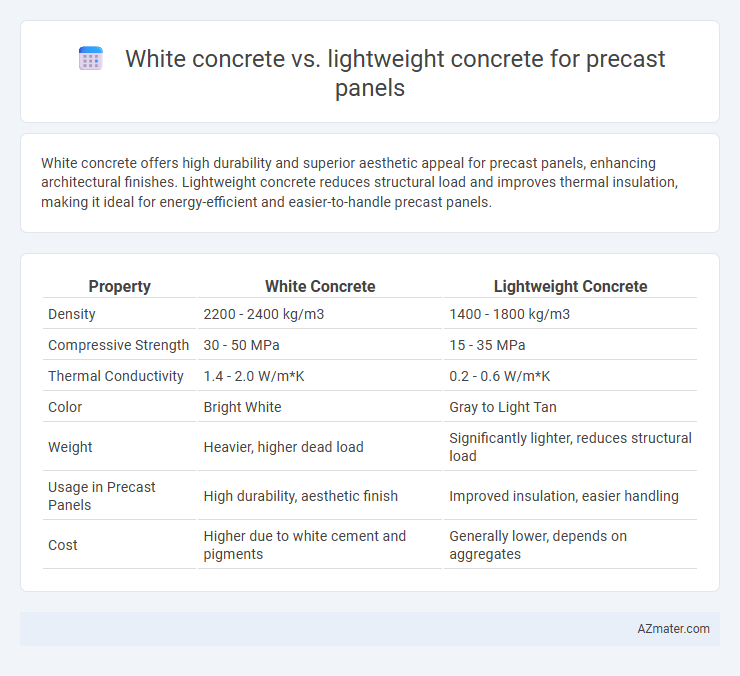White concrete offers high durability and superior aesthetic appeal for precast panels, enhancing architectural finishes. Lightweight concrete reduces structural load and improves thermal insulation, making it ideal for energy-efficient and easier-to-handle precast panels.
Table of Comparison
| Property | White Concrete | Lightweight Concrete |
|---|---|---|
| Density | 2200 - 2400 kg/m3 | 1400 - 1800 kg/m3 |
| Compressive Strength | 30 - 50 MPa | 15 - 35 MPa |
| Thermal Conductivity | 1.4 - 2.0 W/m*K | 0.2 - 0.6 W/m*K |
| Color | Bright White | Gray to Light Tan |
| Weight | Heavier, higher dead load | Significantly lighter, reduces structural load |
| Usage in Precast Panels | High durability, aesthetic finish | Improved insulation, easier handling |
| Cost | Higher due to white cement and pigments | Generally lower, depends on aggregates |
Introduction to Precast Concrete Panels
Precast concrete panels are manufactured in controlled factory environments, offering high precision and durability for building facades and structural components. White concrete provides an aesthetic advantage with its bright, uniform appearance, suitable for architectural finishes, while lightweight concrete reduces overall panel weight, improving handling and installation efficiency. Choosing between white and lightweight concrete depends on project requirements for visual appeal, thermal insulation, and structural performance in precast applications.
What is White Concrete?
White concrete is a specialized form of concrete made using white Portland cement, white aggregates, and minimal iron oxide to achieve its distinct bright appearance. It is widely used in precast panels for architectural applications where aesthetics and color consistency are critical. Compared to lightweight concrete, white concrete offers superior surface finish, durability, and color retention, making it ideal for visible exterior panels and decorative elements.
What is Lightweight Concrete?
Lightweight concrete is a type of concrete that incorporates lightweight aggregates such as expanded clay, shale, or pumice instead of traditional heavy aggregates, resulting in a significantly reduced density compared to normal-weight or white concrete. It offers advantages in precast panel production by reducing the overall weight, improving thermal insulation, and enhancing fire resistance while maintaining sufficient structural strength. This makes lightweight concrete an ideal choice for precast panels in applications where weight reduction and energy efficiency are critical factors.
Material Composition Comparison
White concrete for precast panels primarily consists of white cement, fine white aggregates, and pigments to achieve its bright color and smooth finish, offering high density and compressive strength. Lightweight concrete utilizes lightweight aggregates such as expanded clay, shale, or pumice, which reduce the panel's overall weight while providing good thermal insulation and moderate structural capacity. The choice between white and lightweight concrete depends on balancing aesthetic requirements with weight, thermal performance, and strength needs of the precast panel.
Strength and Structural Performance
White concrete for precast panels offers higher compressive strength typically ranging from 30 to 50 MPa, providing excellent structural durability and load-bearing capacity. Lightweight concrete, with densities between 1400 to 1900 kg/m3, delivers reduced dead load and improved thermal insulation but generally has lower compressive strength, often between 15 to 30 MPa. Structural performance of white concrete panels is superior for high-load applications, whereas lightweight concrete panels optimize structural efficiency in weight-sensitive designs.
Aesthetic Differences and Design Flexibility
White concrete offers a smooth, bright surface ideal for architectural precast panels requiring high visual appeal and a clean, modern look. Lightweight concrete provides greater design flexibility due to its reduced density, enabling thinner panels and complex shapes without compromising structural integrity. The contrasting textures and finishes of white versus lightweight concrete allow designers to tailor precast panels to specific aesthetic and functional requirements.
Weight, Handling, and Installation
White concrete for precast panels offers higher density and weight compared to lightweight concrete, resulting in enhanced durability but increased handling challenges. Lightweight concrete significantly reduces panel weight, simplifying transportation and installation while minimizing structural load. These characteristics directly impact the choice of lifting equipment and on-site labor efficiency during precast panel deployment.
Thermal and Acoustic Insulation Properties
White concrete for precast panels offers superior thermal insulation due to its higher reflectivity, reducing heat absorption and enhancing energy efficiency in buildings. Lightweight concrete provides excellent acoustic insulation by effectively dampening sound transmission through its porous structure, making it ideal for noise-sensitive environments. Combining white concrete's thermal benefits with lightweight concrete's soundproofing qualities results in precast panels optimized for both energy savings and acoustic comfort.
Cost Implications and Sustainability
White concrete for precast panels typically incurs higher material and production costs due to the use of white cement and specialized aggregates, impacting overall project budgets. Lightweight concrete offers potential cost savings by reducing transportation and handling expenses thanks to its lower density, while enhancing energy efficiency and thermal insulation in buildings. Sustainability advantages of lightweight concrete include reduced carbon footprint and better resource efficiency, whereas white concrete's environmental impact is higher because of its energy-intensive manufacturing process.
Choosing the Right Concrete for Precast Panels
White concrete offers superior aesthetic appeal and high compressive strength, making it ideal for architectural precast panels requiring a polished finish. Lightweight concrete provides enhanced thermal insulation, reduced dead load, and easier handling, which benefits structural efficiency and installation speed. Selecting the right concrete depends on balancing visual requirements with structural performance and project-specific factors like load capacity and thermal properties.

Infographic: White concrete vs Lightweight concrete for Precast panel
 azmater.com
azmater.com